How much does it cost to start?
How much does it cost to start a framing business? What equipment is necessary for this job?
How much does it cost to open a frame shop? The answer is not simple. It may depend on the sizes that you want to give to your new business or on the direction that you want to assign. For example, a store with main activity of gallery of paintings has equipment costs different from a shop where the main activity is to framing. Furthermore, the job of framer can be crafted character or can take the form of series production.
The framer activity, finally, can start from scratch or be joined to an already existing activity in a related field.
For example, an already existing painting gallery could decide to add a framing service. Another common example is that of the photographer or the glazier who want to expand his business.
The series is very large so that even the calculation of installation costs is subject to many variables.
For reasons of simplicity we schematically reduced to two cases:
1) A very small workshop for hobby framing
2) Opening of a small shop for framing
HOBBY FRAMING
DIY has been becoming more and more popular and supermarkets that provide equipment and DIY materials are increasingly spread.
Let us consider the case of those who would gear up to make their own frames alone and maybe even for friends.
This category may also include the painters who decide to take your own frames.
The first step is cutting at 45° of the 4 pieces of the frame.
The easiest and least expensive way is to buy the tool that facilitates the 45° cut.
You can find it in the DIY stores or hardware stores.
The alternative is to buy a hand saw, like the one found in the catalog Rinaldin.
|
| Manual Saw for hobby |
| code 12080 - € 85 |
The easiest method of assemble the 4 pieces of the frame is to use only glue and rubber bands.
As for the glue you can use the normal vinyl glue. For the rubber bands you can choose between those of para or latex.
|
| Elastic frame-clamping bands Rubber rings |
To switch to more professional assembly methods, the Rinaldin has a choice of three different underpinners.
 |
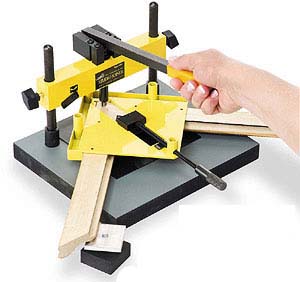 |
 |
||
| Kit for beginners "PFK4" | Underpinner "Studio Joiner" | Underpinner Minigraf "A2M" |
||
| code PFK4 - € 89 | code F3001 - € 205 | code U200 - € 1.100 |
||
| Click here to watch the video | Click here to watch the video | Click here to watch the video |
The cutting and assembling of the 4 pieces of the frame form the basic equipment of a small hobby workshop.
Let us see what equipment is used for the other operations of the frame.
For the glass cutting a glass cutter and a square is enough. The cost of a glass cutter with oil tank is about 21 euro.
A square for glass of 110 cm costs 39 Euro.
For the cutting of cardboard and mountboards a simple cutter of a few euro is enough.
To bevel cutting of the mat Rinaldin proposes the following matboard cutters produced by Logan:
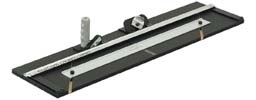 |
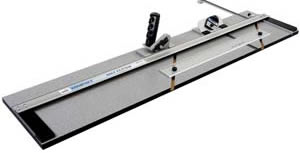 |
||
"Logan 301" cutter |
"Logan 350" cutter |
||
Cutting length cm 73 - € 145 |
Cutting length cm 81 - € 175 |
||
| Click here to watch the video | Click here to watch the video | ||
 |
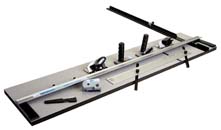 |
||
"Logan 450" cutter |
"Logan 750" cutter |
||
Cutting length cm 102 - € 290 |
Cutting length cm 100 - € 490 |
||
| Click here to watch the video | Click here to watch the video |
For the cutting of ovals and rounds you can choose the "Logan201". This tool, however, is not indispensable for the hobbyist.
 |
"Logan 201" cutter |
€ 66 |
| Click here to watch the video |
To secure the cardboard to the frame we advise a stapler that fires brads, such as the F18, or the Frame Master and the T225 that fire tabs.
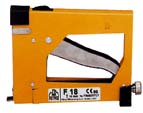 |
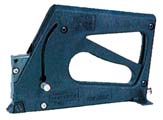 |
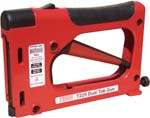 |
|||
Tab driver "F18" |
Tab driver "Frame Master" |
Tab driver "T225" |
|||
€ 84 |
€ 122 |
€ 29 |
Then you need other commonly used tools as pincers, pliers, hammer, scissors, cutters with breakable blades, adhesive tape dispenser, etc.
 |
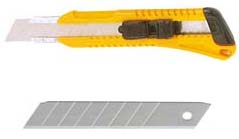 |
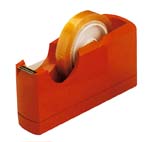 |
|||
Toyo glass cutters |
Breakable bladed cutters |
Sellotape |
From the above it is clear that it is not easy to calculate the installation cost of a small workshop of hobby framing. The choice of equipment, in fact, can affect in a consistent way the total cost. We here are two examples:
Hobby workshop with limited equipment:
• |
|
Manual saw | € 85 |
• |
|
Underpinner Studio Joiner by Logan | € 205 |
• |
|
Tab driver F18 | € 84 |
• |
|
Glass cutter | € 21 |
• |
|
TOTAL | € 395 + transport |
Hobby workshop with good equipment:
• |
|
Manual Saw |
€ 85 |
• |
|
Underpinner U200 by Alfamacchine |
€ 1.100 |
• |
|
Cutter "Logan 450" - 102 cm |
€ 290 |
| • | Oval cutter Logan 201 | € 66 | |
• |
|
Tab driver F18 |
€ 84 |
• |
|
Glass cutter Toyo |
€ 21 |
• |
|
TOTAL |
€ 1.646 + transport |
INSTALLATION OF A SMALL WORKSHOP OF A FRAMER
First you have to buy a machine for cutting at 45° the mouldings, namely a guillotine or a circular saw.
The choice is not easy. The guillotine has the advantage not to make powder, to be silent, to make simultaneously the right and left cut.
Rinaldin proposes the guillotine “Morso F" that is the best known and most used guillotine in the world.
 |
Guillotine Morso "F" |
code 381F - € 2.700 |
| Click here to watch the video |
The saw has the advantage of more easily cut big mouldings especially if the wood is particularly tender. The price of a guillotine is roughly equivalent to that of a saw equipped with a dust collector system and measuring tables.
Rinaldin offers the circular saws "Pegic GP350".
The Pegic 350, solid and professional, can cut up to a width of 13 cm.
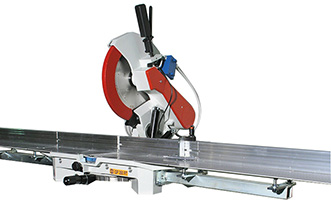 |
 |
|
Mitre saw"Pegic GP350" |
Mitre saw, basement and accessories |
|
| code GP350 - € 4.550 | about € 5.750 |
An alternative to the purchase of the guillotine or the saw could be the "Chop Service". It consists in the purchase of mouldings already cut at 45° to the required sizes. Abroad (especially in USA) the chop service is heavily used. Statistics say that more than 80% of American framers buy with this system.
To join the frames you need an underpinner. There are various types on the market. For a small framer workshop a simple air underpinner is sufficient.
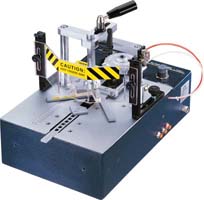 |
Underpinner U300 |
| code U300 - € 1.750 |
| Click here to watch the video |
To operate the air underpinner you need a compressor which can also be used for other machines and, in particular, for air guns and air staplers.
The compressor must be at least 24 liters, and possibly noiseless.
 |
Silenced compressor SIL-AIR 50/24 |
| code 343 - € 530 |
The small equipment includes:
Staplers. Indispensable a manual stapler like the F18 or the Frame Master that fire brads. Also indispensable manual stapler like Rapid or Rocama that fire steel staples.
 |
 |
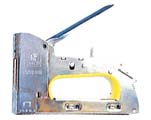 |
 |
|||
F18 nailer |
Tab driver Frame Master |
Stapler Rapid |
Stapler Rocama |
|||
| € 84 | € 122 | € 64 | € 66 |
Glass Cutter. To cut the glass there is no alternative: the glass cutter Toyo has become a standard.
Square for glass. They come in various sizes. Better to have two, one large and one small.
Knife for cardboard. To cut the cardboard the best solution would be a professional cardboard guillotine but, because of its relatively high cost, perhaps a simple fixed blade knife could be enough.
Mount cutters. In addition to cutters seen above, we can add these two, which are more professional:
 |
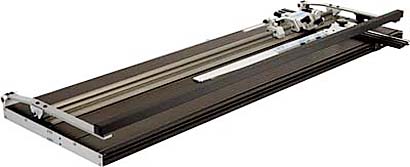 |
|
Mountcutter Keencut "Ultimat Futura" |
Mountcutter Logan "850-855-860" |
|
| Cutting length cm 122 - € 1.980 | Cutting length cm 102 - € 1.280 | |
| Cutting length cm 122 - € 1.400 | ||
| Cutting length cm 152 - € 1.480 | ||
| Click here to watch the video |
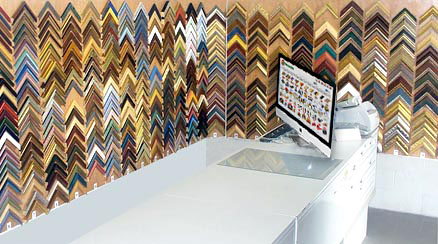 |
Presentation system of corner samples created by Rinaldin |
| Click here to watch the video |
The total cost of machines and equipment is shown in the following table:
• |
|
Saw or guillotine (with extension and spare blade) |
€ 4,650 |
• |
|
Pneumatic underpinner (average price) |
€ 1,750 |
• |
|
Silenced 24 liter compressor |
€ 530 |
• |
|
Toyo glass cutter |
€ 21 |
| • | 2 triangles for glass | € 70 | |
• |
|
Manual nailer (F18 or Frame Master) |
€ 100 |
• |
|
Manual tacker (Rocama or similar) |
€ 66 |
• |
|
Bevel cutter for cartons (average price) |
€ 1,400 |
| • | Lowe scissors for slips and spacers | € 58 | |
| • | Logan cutter for oval bevel cuts | € 66 | |
| • | Various small equipment | € 350 | |
| • | Presentation system for corner samples | € 350 | |
| • | NET TOTAL | € 9,411 | |
| • | Transport (average cost) | € 200 | |
| • | GENERAL TOTAL | € 9,611 |
These are average prices taken from the catalog Rinaldin 2025. Note that in the count no cost was included in relation to working benches, electric utility costs, heating, telephone etc. There were not even included the costs of the shop counter, showcase, lighting, heating, computer and software for framers, etc.
These, in facts are elements subject to numerous variables from case to case that a beginning framer must personally evaluate. However, we believe that a total cost of these elements should amount to at least 6,000 euro.
Of course the equipment is not enough to manage a laboratory of frames. It also wants the materials.
We see very briefly the materials used in the workshop of the beginner.
First of all the mouldings. A minimum assortment of mouldings consists of about 20 meters of moulding for about 30 models. At an average price of 4 euro per meter the total is about 2,500.
We have seen that the alternative could be, at least initially, the Chop Service, namely the purchase of mouldings already cut at 45° in the required sizes.
A purchase advisable for the beginners is a series of corner samples for display in the store (even without keeping the mouldings). The complete set of corner samples of Rinaldin (about 1400 models) costs 320 €.
As for the glass we take as a basis the average cost of a crate of 500 square meters at 4 euro per sq m.
The mouldings and the glass are the most relevant entries of the workshop as shown in the following scheme:
• |
|
Mouldings (approx. 20 meters per 30 models) |
€ 2,500 |
• |
|
Samples of mouldings |
€ 320 |
• |
|
Glass (one box) |
€ 2,000 |
• |
|
Gray carton |
€ 150 |
| • | Mountboards | € 350 | |
• |
|
Canvas for fabric mountboards |
€ 150 |
• |
|
Various small equipment |
€ 150 |
• |
|
Wedges for underpinner |
€ 150 |
| • | Other various materials | € 770 | |
| • | TOTAL | € 6,500 |
The beginner must take into account that then to safely handle a store you need some working capital to meet financial commitments and contingencies that are certainly present in the first few months.
We think that working capital should not be less than EUR 7,500. The lack of working capital is the main cause of the high infant mortality rate of businesses.
In the following scheme we briefly outline the figures:
• |
|
Machines and equipment |
€ 10,000 |
• |
|
Establishment price |
€ 6,000 |
• |
|
Initial purchase of materials |
€ 6,500 |
• |
|
Working capital |
€ 7,500 |
| • | TOTAL | € 30,000 |
An approximate total of 30,000 Euros (plus VAT) represents the minimum capital that a beginner should dispose if he wish to open a store from scratch.
The amounte may vary considerably depending on the circumstances. If, for example, the framer activities is joined to an existing line, the amount should be reduced by about 10,000 euro because it is assumed that there is already a working capital and that some of the various expenses of installation has already been performed.
For reasons of simplicity we have shown only two cases. Obviously, there are intermediate positions that the aspirant framer may adopt depending on the circumstances and financial availability.